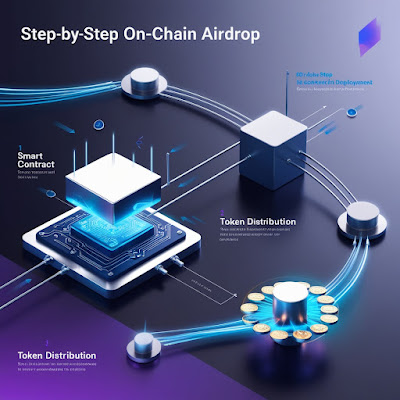In the dynamic realm of cryptocurrencies, on-chain airdrops and on-chain withdrawals have emerged as fundamental processes for users and developers alike. These blockchain-based activities are crucial for ensuring transparency, security, and decentralization within the crypto ecosystem. Here’s a detailed look at how these processes function and their significance for crypto enthusiasts.
What is an On-Chain Airdrop?
An on-chain airdrop refers to the direct distribution of tokens or digital assets from a smart contract to users' wallets, eliminating the need for intermediaries. On-chain airdrops take advantage of the decentralized characteristics of blockchain technology, in contrast to traditional airdrops that frequently require central institutions. This method enhances transparency since all transactions are recorded on the blockchain and are publicly auditable.
The key benefits of on-chain airdrops include:
- Transparency: Every transaction is logged on the blockchain, ensuring open access to distribution records.
- Security: The absence of intermediaries reduces the risk of fraud and manipulation.
- Fair Distribution: Tokens are allocated fairly based on specified criteria.
- Community Engagement: Airdrops encourage greater participation and activity within the crypto ecosystem.
How Does an On-Chain Airdrop Work?
- Smart Contract Deployment: A smart contract is set up on the blockchain to manage the airdrop process.
- Eligibility Criteria: The contract defines requirements such as owning certain NFTs or participating in specific decentralized applications (dApps).
- Token Distribution: When the contract conditions are met, it automatically sends tokens to eligible wallets.
- Token Claiming: Certain recipients might have to communicate with the smart contract in order to manually claim their tokens.
What is an On-Chain Withdrawal?
On-chain withdrawals involve transferring assets from one blockchain wallet to another or to an external storage solution. These transactions are verified and recorded on the blockchain network. While secure, on-chain withdrawals typically incur transaction fees, which can vary based on the blockchain's congestion. These fees compensate for the computational resources used to process and validate the transaction.
How Do On-Chain Withdrawals Work?
- Initiation: The user specifies the withdrawal amount and destination address.
- Transaction Creation: A digital signature is used to confirm the withdrawal request.
- Broadcasting: The request is sent to the blockchain network for validation.
- Verification: Network nodes verify the transaction before it is included in a block.
- Confirmation: Once validated, the assets are transferred to the designated wallet.
The Connection Between On-Chain Airdrops and Withdrawals
Receiving an on-chain airdrop often necessitates making an on-chain withdrawal to move tokens to exchanges or other wallets. This process ensures the secure handling and mobility of assets within decentralized networks.

